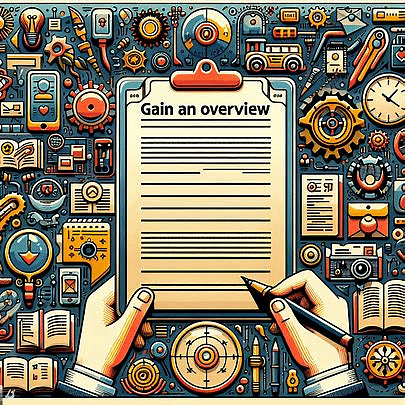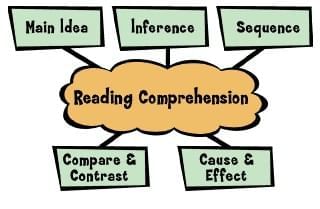6 Golden Rules for Comprehension | Verbal Ability & Reading Comprehension (VARC) - CAT PDF Download
Introduction
- The Reading Comprehension section in the exam is crucial for evaluating a candidate's ability to understand and analyze complex passages. It goes beyond just testing reading speed and includes assessing comprehension, logical reasoning, and vocabulary.
- Passages cover a wide range of topics from various fields. After reading challenging passages, candidates face questions that test their understanding, inference-making, and conclusion-drawing skills.
- Mastering this section is vital as it significantly impacts the overall score and reflects real-world demands where effective comprehension and critical analysis are essential.
- Aspirants must develop a strategic approach and hone the necessary skills to excel in this challenging yet important part of the exam.
- The word 'comprehension’ actually means ‘grasping with intellect’ and ‘understanding.’
- Reading comprehension strategies are tools that everyone can use to help understand the meaning of what they read.
 6 Golden Rules for Comprehension
6 Golden Rules for Comprehension
Golden Rule 1: Analyse the 'Non-Verbals'
- Before commencing reading, you should take a few moments to look at the non-verbal forms of communication in the document you wish to comprehend.
- The non-verbals are the messages that are not contained in words, but rather in the design of the document.
- The ‘non-verbals’—such as tone, structure, punctuation, and transitions—help us understand what the author really means.
- You should flick through the document and first look at the photographs, pictures, charts, and graphs. Scrutinize these items and build a mental picture of what the document is saying. Pictures allow a very rapid way of comprehending the material and the human brain is typically much better at remembering pictures than words and verbal concepts.
- Look at the quality of the document. Does it have a professional layout? Is it well structured? Viewing the non-verbals is an important prelude to the next phase as it prepares our minds to receive and analyze information.
Question: What did Einstein's theory of relativity primarily change?
Golden Rule 2: Gain an Overview
A golden rule of great comprehension is to gain an overview of the passage in front of you. This means reading selective parts of the passage until you gain a perspective.
Before diving into a passage, scanning key elements can help you understand its structure, identify important ideas, and save time:
- Read the first and last paragraph carefully: The introduction sets the context, while the conclusion often summarizes the passage’s main idea.
- Glance at the first sentence of each paragraph: This helps in understanding the passage’s flow without reading every word.
- Pay attention to numbers, names, and dates: These details frequently appear in fact-based questions.
Once you have gained a mental picture of the passage, you can then dive into it!
Golden Rule 3: Understand Purpose
When reading, it is important to consider two things.
(i) First, identify what you need to extract based on the question type:
- Main Idea Questions: Skim the first and last sentences of each paragraph to grasp the overall theme.
- Inference & Critical Reasoning Questions: Read carefully, focusing on contrast words (however, but, yet) and the author’s logic.
- Fact-Based Questions: Scan for keywords related to the question instead of reading everything.
- Tone & Perspective Questions: Look for emotionally charged words that reveal the author’s attitude.
(ii) Second, what did the author set out to achieve in writing the text?
- Were they trying to describe something?
- Were they writing an informative text?
- Were they explaining something?
- Are they writing instructions?
- Are they trying to persuade you to a point of view?
By understanding what to extract from the passage and what the author intends to convey, you can approach RCs strategically. Instead of reading passively, engage with the text by identifying key ideas, scanning for relevant details, and recognizing the author’s purpose. This sharpens your comprehension, improves accuracy, and helps you manage time efficiently, giving you a strong edge in the exam.
Golden Rule 4: Decide on your Response
- Being an effective reader is not about reading and understanding everything that comes your way. It is about matching your response to information with its relevance and importance.
- The time-tested 80 / 20 rule applies to reading too. Only about 20% of the passage contains the core ideas that require deep comprehension, while the remaining 80% consists of supporting details and examples. Instead of trying to absorb everything, a smart reader identifies the key parts that need close reading while quickly skimming the rest. Mastering this skill helps in saving time and improving accuracy during the exam.
- From this information, you might want to take notes, apply a coloured highlighter, and prepare action items after you read it.
Question: What is a major consequence of deforestation in the Amazon rainforest?
Golden Rule 5: High Comprehension Reading
- At this stage, you have gained an overview of the passage by viewing the nonverbals, and by building a mental summary of the passage by reading the key parts.
- Now you are motivated. Motivation is critical for great comprehension as motivation leads to focus and concentration, both of which are essential ingredients necessary to engage your memory in learning mode. As you are reading involve as many senses as you can in the reading process; this will greatly contribute to your understanding and recall:
- Make notes.
- Draw pictures of the information (Example: Mind maps)
- Highlight keywords
- Scribble notes in the margin
- Make mental notes of the key phrases.
Golden Rule 6: Use Targeted Strategies for Challenging Question Types
Some reading comprehension questions are more challenging and require specific techniques to answer correctly. Here’s how to approach three common tough question types:
- Main Idea Questions: For these questions, look at the beginning and ending lines of each paragraph. Authors often introduce or conclude their main points in these parts, which can reveal the passage’s central theme. Scanning these lines gives you a sense of the overall argument, which is what a main idea question typically tests.
- Choosing the Best Title: When selecting a title, avoid ones that are too narrow or overly broad. An effective title should capture the main idea without missing out on key subtopics discussed in the passage. For example, if a passage about the benefits of renewable energy sources mentions solar, wind, and hydropower, a title like “The Role of Renewable Energy” would be better than “Solar Power’s Advantages.” A title should encompass the primary theme and represent all the major points in the passage.
- Determining Tone or Mood: Tone questions require you to look for emotional cues in the text. Words with positive emotions, like encouraging, optimistic, or successful, indicate a positive tone, while words like concerned, doubtful, or pessimistic hint at a negative tone. Analysing these tone-setting words helps you infer the author’s mood or attitude, making it easier to identify the tone accurately.

How to Crack Reading Comprehension Section
- Prepare: Getting ready in advance is key. Solve practice tests, read books, study important material, take notes, and focus on acing reading comprehensions.
- Practice: Regular practice keeps your mind in the right mode. The more you practice, the easier the actual reading comprehension will become. Daily activities like reading, writing, and problem-solving contribute to effective RC practice.
- Patience: Take your time while reading the comprehension. Rushing through it will waste time because you won't grasp anything, leading you to repeatedly return to the passage to find answers.
- Develop a Reading Habit: Make a habit of reading every day. Include light reading in your schedule, such as news or a few pages of your favourite novel. Work on improving your reading speed, and diversify your reading materials to cover various topics.
- Create Your Approach: Develop your unique approach to solve the reading comprehension. Apply this approach during mock tests to be well-prepared for the actual entrance exam. Having a clear plan enhances both organisation and speed.
- Keyword Focus: Before diving into the comprehension, glance through the questions to identify keywords. This strategy helps you understand what the questions are asking, saving time during the initial reading of the comprehension.
- Mock Test Practice: Make sure to solve numerous mock tests while preparing for your exam. Regularly engaging with new comprehension passages will make solving the actual exam's comprehension feel like a routine task.
- Skimming Technique: Before delving into the comprehension, quickly skim through the passage. Highlight important points to grasp the essence, making it easier to understand when you read it more thoroughly.
Tips from the Toppers
1. Daily Practice: Consistent daily activities, like reading articles and solving reading comprehension (RC) passages, are crucial for building vocabulary and comprehension skills. This habit helps in preparing for exams by familiarising you with different styles and complexities.
2. Topic Familiarity: Familiarising yourself with a wide range of subjects, such as science, technology, history, and economics, can boost confidence in tackling any passage, making it easier to understand dynamic and unfamiliar topics.
3. Active Engagement: Active reading techniques, like summarising key points, asking questions, and predicting content, deepen understanding and improve retention, especially under exam conditions.
4. Time and Error Management: Practising under timed conditions improves speed and accuracy, while analysing mistakes from practice tests helps in learning and avoiding errors, enhancing overall performance.
EduRev Tip: For a detailed insight about how to score a perfect in RCs, click here.
|
184 videos|798 docs|126 tests
|
FAQs on 6 Golden Rules for Comprehension - Verbal Ability & Reading Comprehension (VARC) - CAT
| 1. What are the key strategies outlined in the article for improving reading comprehension? |  |
| 2. How can analyzing 'Non-Verbals' help in reading comprehension? |  |
| 3. What does it mean to 'gain an overview' when reading a passage? |  |
| 4. Why is understanding the purpose of the text important in reading comprehension? |  |
| 5. What are some targeted strategies for answering challenging question types in reading comprehension? |  |

















